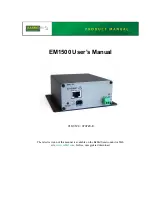
1
ZENA™ Power Generator Testing (all models)
Belt Drive
Proper belt drive efficiency is key to insuring long term trouble free generator operation.
This is achieved by having three things in balance -- drive pulley size, drive pulley belt
wrap, and proper belt tension. Not too loose and definitely not too tight. If things are in
balance, belt tension will be correct and the belt will not slip.
A quick method of checking belt tension and slip is to span the generator pulley with the
thumb and forefinger of both hands. Then try to turn the generator in the direction of its
normal rotation for V-belt drive, and in the opposite direction for serpentine/flat belt drive
installations, using as much rotational force as you can exert by hand while carefully
observing belt tension on each side of the generator pulley. Unless you are VERY strong,
you should not be able to get the belt to slip. And, just as important, you should see/feel a
slight amount of slack in the belt on one side of the pulley.
Static test belt tension can also be tested (a bit more accurately) by using a properly sized
socket wrench on the power generator’s pulley bolt to try to rotate the power generator in the
direction of its normal rotation for V-belt drive installations, and in the opposite direction for
serpentine/flat belt drive installations. The pulley should be quite difficult to turn using
moderate hand pressure. Often an engine will "turn over" before any belt slip will be noted.
At the same time, you should notice a very slight slackening of the belt tension on one side
of the pulley. If any slippage is noted, the point of failure should be easy to determine.
Belt tightness should be rechecked after the first few of hours of operation.
Electrical Function
You can easily check for a component failure in the Power Generator by following the
following procedure.
Disconnect the two wires which are used to connect the Control Module or Voltage
Regulator to the Power Generator’s control (1/4” spade) terminals, and check in the
electrical resistance between
either
of the terminals and the
case
of the Power Generator.
A normal reading is an “open” circuit (an infinite resistance).
If your meter shows
any
measurable resistance, in either test, your Power Generator has
either a brush assembly, or rotor assembly failure, and should be returned for repair
1
.
If your meter shows
no
measurable resistance, check the electrical resistance
between
the
two Power Generator control (1/4” spade) terminals with an ohm meter. A normal reading
is between 1.8 and 2.4 ohms
2
. If your meter shows a resistance of
less than 1.8 ohms
, your
Power Generator may have a rotor failure (or the remote possibly that there is a piece of
foreign matter bridging the brushes), and should be returned for repair
3
.
If the electrical resistance measured between the control terminals is
higher than the
“normal” range of 1.4 to 2.4 ohms
4
(for example, 10 ohms, or 20 ohms, or more) it is
1
If desired, this component is field replaceable by a competent technician (or skilled owner).
2
A reading of as much as 3-5 ohms may be “normal” – a result of a brush being slightly out of position when the
generator is not rotating. Spin the generator and retest if this sort of reading occurs.
3
If desired, this component is field replaceable by a competent technician (or skilled owner).
4
A reading of as much as 3-5 ohms may be “normal” – a result of a brush being slightly out of position when the
generator is not rotating. Spin the generator and retest if this sort of reading occurs.
Содержание 150 series
Страница 4: ......






























